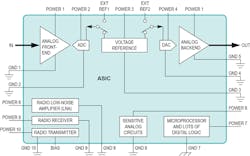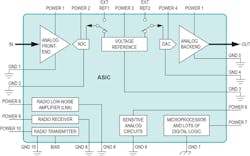Good ASICs enjoy greater than 90% first silicon success. So why do we need to “fix” the process? After all, the ASIC almost works, and there is no time to spin it and still meet the market window. Sound familiar? Unfortunately, Murphy’s Law—anything that can go wrong will go wrong at the worst possible time—applies here.1
Related Articles
- Passive Components Aren't Really So Passive (Part 1): Capacitors
- Work Through All Your Choices Before Making Your Efficiency Tradeoffs
- Design For Power Efficiency Like A Symphony Conductor
No matter how we simulate, build FPGAs, and prototype, there will be surprises. Small things will need improvement. And just when you think you’re getting close, the sales team will say it can’t sell the device without another “little” feature. Of course, the deadline for introduction cannot be extended. This drama is hardly unfamiliar, and it can be the ASIC designer’s nightmare.
Digital circuits are relatively easy to fix because they tend to be black or white, on or off. But what happens when there is an analog issue on the ASIC? This can be daunting. Analog issues include things that almost work correctly. It’s just a little noisy. It needs a little more gain. It needs a minor adjustment to calibrate it, bring it into range, or compensate for another component’s tolerance. If optimizing ASICs were so straightforward, many of us would drink less coffee and sleep better.
We see the analog design mistakes on ASICs all the time. We pick up a board and over in the corner is a piece of “oops logic,” a design feature that seemed right at the time but is clearly not working now. But there are ways to fix the “oops.”
External circuits can be added to make many of these ASICs operational for prototyping or, in many cases, shippable products. Designers also can correct noise in analog circuits, make adjustments, calibrate gain and offset, and clean power sources. The payoff will be everyone’s goal: quicker time-to-market and even avoiding an extra ASIC manufacturing spin.
Optimizing To Reduce Noise
Noise is common in mixed-signal ASICs, primarily because digital-logic switching noise gets into sensitive analog circuits. Figure 1 illustrates the best-case layout where each block has its own power and ground pin. Nonetheless, the digital circuits are switching current with fast edges that crosstalk and bounce the grounds and power pins.
This layout would be ideal if there were two die (one analog and one digital) in the same package, built much like a hybrid. That configuration would allow two truly separate grounds because the circuits would not share a common silicon substrate. Alas, in the real world this ASIC will be one die, but it is still important to have as many separate power and ground pins as possible. We then will have the most flexibility when we are troubleshooting and fixing issues.
Switching Noise
We start our examination of the Figure 1 circuit with the lower right corner, the microprocessor and the other digital logic, which are sources of switching noise.
1. An ASIC block diagram shows the best-case layout where each block has its own power and ground.
The inexperienced designer might note that the clock is only 1 MHz. This is true, but the edge of a perfect square wave has odd harmonics extending to infinity. In practice the most energy is in the first five to seven harmonics.
Also in a clocked system, the clock makes the edges coincide except for propagation delays.
2. A typical CMOS input or output circuit uses current to charge the capacitance of the next stage and during the switching time when both transistors are partially on.
Finally, a CMOS output draws current during the switching time. Figure 2 shows the current used in two ways: one, to charge the capacitance of the next stage, and two, during the switching time, both transistors are partially on (Fig. 3). It is a small current, but it adds up when there are literally millions of transistors switching.
3. Voltage on a CMOS input pin versus power-supply current. Data are for the MAX5391 digital potentiometer.
Where does this get us? Some designers discriminate between power and ground domains with the terms analog and digital. We prefer the terms clean and dirty, respectively, as it helps with the thought process.
Inside the ASIC the ground can bounce, introducing digital ground noise into the analog circuits. Consequently, these two ground domains need to connect at one system star point to keep their noise separated.2 The power-supply decoupling capacitors need to be chosen with the capacitor’s self-resonance in mind.3 The thresholds in digital logic remove noise, whereas analog circuits have no thresholds.4
Improving SNR To The ADC
The analog front end (AFE) that feeds the analog-to-digital converter (ADC) comprises a multiplexer, amplifiers, and filters. If the ADC signal is noisy, we look at the signal-to-noise ratio (SNR) of the input signal to determine what we can improve. There are several straightforward questions to ask:
• Is the full range of the ADC utilized?
• Can we add gain or offset with an amplifier and digital pots to center and optimize the signal range?
• If the input signal is too noisy, can we clean up the source’s power supply, even going to a low-noise reference to power it?
• Is there out-of-band (OOB) radio frequency interference (RFI) or electromagnetic interference (EMI)?
• Can we shield the circuit, add twisted wires, use a differential input amplifier, or add a lowpass filter to common-mode out the noise?5, 6
The short answer to these questions is yes. Designers can take one or more of these actions before the ASIC input.
Another common issue is the source of the signal into the AFE. Let’s say that a sensor may not be available or may need to be replaced with another manufacturer’s part. The situation becomes even more complex because that replacement part may have different output qualities. It may need impedance transformation, gain, or offset with an external amplifier to continue comparable operation. The AFE itself may be too noisy, so can we do a better job of decoupling the power possibly with a series inductor, resistor, or ferrite bead? The low-noise voltage reference can also work here as a power-supply replacement.
Moving to the right on Figure 1, we see a voltage reference that could feed both the ADC and digital-to-analog converter (DAC). There is also a switch option to feed the ADC with an external lower-noise voltage reference. This simple change could improve the ADC’s SNR. If you use a voltage reference that is adjustable or trimmable, you can adjust the full-scale amplitude of the ADC or DAC.
DAC Output Noise
Look now at the top right blocks of Figure 1, where we find the DAC followed with an analog back end made of amplifiers and filters. There is a quick way to evaluate the noise at the DAC and output conditioning: set the DAC to output three dc voltages, 10%, 50%, and 90%, of its range. We choose 10%, 50%, and 90% to avoid clipping or compression and to stay in the linear signal area.
The typical DAC reference input is connected to full scale and the zero scale to ground. Therefore, to understand the source of the noise, change the DAC dc value. (A spectrum analyzer is very helpful here.) The noise from the reference or power supplies will be more pronounced near full scale. Any ground noise will prevail near zero scale.
Switching between the internal and external voltage references will reveal differences in that noise source. Also be careful about interactions between the ADC and the DAC through the common voltage reference. Stepping the DAC with a clean dc on the ADC will show crosstalk through the reference path. And, it may be necessary to add an external amplifier for filtering, digital potentiometers for gain, and offset adjustments and impedance conversion.
Powering The Radio
There are three radio blocks at the lower left of the ASIC. Radios are interesting because the transmitter can block or desensitize the receiver. The digital switching noise can do the same thing. This is a good place for a real-world example of what can go wrong, a very disruptive “oops” in a design.
Some years ago a company provided an upgraded cell phone that also allowed e-mail access. The old phone worked at my home with good SNR. The new phone required more signal to work. The design flaw became obvious: the extra digital circuits for the e-mail function were so noisy that the phone receiver could not operate as intended. We had to install a cell-phone repeater on the roof that repeated the signal in my home office to make the new phone work.
What does this mean for ASICs? Cell phones are duplex devices—that is, they simultaneously transmit and receive on different radio frequencies. A specialized filter called a duplexer allows the duplex communication. It keeps the receiver from being confused by the higher-power transmit frequency. However, signals can leak around the duplexer and cause issues.
By definition, the duplexer does not effectively remove digital switching noise. The radio receiver signal comes through a low-noise amplifier (LNA). As in most systems, the first amplifier sets the SNR because the following amplifiers see a higher signal. Therefore, they do not contribute as much to the overall SNR.
The most sensitive power supply is the one feeding the LNA. Replacing this supply with a low-noise voltage reference can work wonders to improve receiver performance. The radio transmitter may also use an external MOS transistor to augment the power needed. This transmitter may need calibration to meet the maximum power output standards of the U.S. Federal Communications Commission (FCC) or the radio regulatory agencies in other countries.
For example, if the component tolerances in the transmitter allowed the power to vary ±10%, the tolerances would need to be reset so the radio output could be between 80% and 100%. To be legal, the output power can never be above 100%. A lower power means that the range of the radio would be reduced.
A simple calibration of power out in final test will guarantee the maximum radio range and performance. Calibration allows compensation for those tolerances, and a simple digital potentiometer connected to the power amplifier bias pin ensures full power radio output.7
Look now at the last block of Figure 1 and its “sensitive analog circuits.” We don’t know exactly what they are! We might guess: a microelectromechanical systems (MEMS) accelerometer, a touchscreen, an LCD, a microphone input, an audio output, a light sensor, a face sensor, a dew or humidity sensor, a temperature sensor, and so it goes.
We live in an analog world and we need to sense it, convert it to digital, process it, and then convert it to analog to control it. At the very least, this example needs to add a digital potentiometer for calibration of LCD contrast if the manufacturer has a voltage tolerance greater than expected or if it is necessary to use two manufacturers’ products to meet the delivery numbers. Calibrating the LCD bias with a digital potentiometer in the factory allows the existing ASIC to function without time-consuming rework.
Conclusion
How many other ASIC issues might we solve with simple fixes that do not require another complete layout pass? We will never know until we see them and try. Engineers know Murphy and his law is always lurking in the shadows of the design lab. That is why every smart ASIC designer needs an experienced analog engineer to anticipate problems and to fix analog noise issues (the “oops”) that disrupt the product time-to-market.
References
1. For a discussion of the meaning and history of Murphy’s Law, start with the Wikipedia entry: http://en.wikipedia.org/wiki/Murphy%27s_law.
2. Maxim Integrated application note 4605, “Avoid Design Misinterpretations that Put System Operation in Jeopardy,” at www.maximintegrated.com/AN4605.
3. Maxim Integrated tutorial 4992, “Reduce the Chances of Human Error: Part 1, Power and Ground,” at www.maximintegrated.com/AN4992.
4. Maxim Integrated application note 4345, “Well Grounded, Digital Is Analog,” at www.maximintegrated.com/AN4345.
5. Maxim Integrated tutorial 5065, “Radio Susceptibility—Cure with Antibiotic, Vaccine, or the Laws of Physics?” at www.maximintegrated.com/AN5065.
6. Maxim Integrated application n4644, “Use a Twist and Other Popular Wires to Reduce EMI/RFI,” at www.maximintegrated.com/AN4644.
7. For a list design calculators, calibration parts, DACs, digital pots, and references optimized for calibration applications, go to www.maximintegrated.com/cal.
Bill Laumeister is an engineer in strategic applications with the Precision Control Group at Maxim Integrated. He works with customers who use DACs, digital potentiometers, and voltage references. He has more than 30 years of experience and holds several patents.
About the Author
Bill Laumeister
Bill Laumeister is an engineer in strategic applications at Maxim Integrated Products. He works with customers who use Maxim’s analog and digital integrated circuits. He has more than 30 years of experience and holds several patents.



